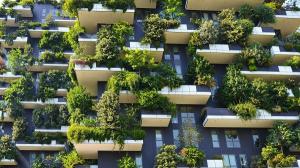Green building materials are eco-friendly products that are toxic-free, good for health, cost-affordable, and promote energy conservation. P
NC, UNITED STATES, February 4, 2025 /EINPresswire.com/ -- The global push towards sustainability and environmental consciousness has fueled the demand for green building materials. These materials, designed to reduce carbon footprints, improve energy efficiency, and enhance occupant health, are shaping the construction industry. With governments implementing stringent environmental regulations and consumers becoming more eco-conscious, the Green Building Materials Market is poised for significant expansion.The green building materials market encompasses a wide range of products, including recycled materials, energy-efficient insulation, sustainably sourced wood, and non-toxic finishes. These materials offer environmental benefits by reducing energy consumption, minimizing waste, and lowering greenhouse gas emissions. The increasing adoption of green certifications, such as LEED (Leadership in Energy and Environmental Design) and BREEAM (Building Research Establishment Environmental Assessment Method), is further propelling the market forward.
Green Building Materials Market Size was valued at USD 357.48 Billion in 2023. The Green Building Materials industry is projected to grow from USD 397.16 Billion in 2024 to USD 998.41 Billion by 2032, exhibiting a compound annual growth rate (CAGR) of 12.2% during the forecast period (2024 - 2032)
Get Sample of the Report - https://www.marketresearchfuture.com/sample_request/1865
Key Market Drivers
Growing Environmental Concerns
Rising awareness regarding climate change and resource depletion has led to an increasing preference for eco-friendly construction materials.
Government Regulations and Incentives
Many countries have introduced policies and tax incentives to encourage the use of sustainable building materials, promoting energy-efficient construction practices.
Advancements in Technology
Innovations in materials science, such as self-healing concrete, energy-efficient glazing, and aerogel insulation, are driving market growth.
Increasing Consumer Demand
Homeowners and businesses are prioritizing sustainable living and energy-efficient buildings, leading to higher demand for green building materials.
Market Segmentation
The green building materials market can be categorized based on type, application, and region.
By Type:
Structural Materials: Recycled steel, engineered wood, and cross-laminated timber.
Insulation Materials: Cellulose, wool, and spray foam insulation.
Interior Finishes: Low-VOC (volatile organic compound) paints, bamboo flooring, and reclaimed wood.
Exterior Materials: Green roofs, solar panels, and cool roofs.
By Application:
Residential Construction: Growing urbanization and the demand for sustainable homes are fueling this segment.
Commercial Buildings: Office spaces, shopping malls, and hotels are increasingly adopting green materials to meet sustainability goals.
Industrial and Institutional Buildings: Factories, hospitals, and educational institutions are integrating green building materials for long-term cost savings and environmental benefits.
Regional Insights
The green building materials market is expanding across various regions, with North America, Europe, and Asia-Pacific leading the way.
North America
The U.S. and Canada are at the forefront due to strict environmental regulations and incentives for green construction.
The LEED certification system is widely adopted, encouraging sustainable practices.
Europe
Countries like Germany, the U.K., and France are prioritizing eco-friendly construction through initiatives such as the European Green Deal.
Demand for energy-efficient insulation and sustainable roofing solutions is increasing.
Asia-Pacific
Rapid urbanization and industrialization in China, India, and Japan are driving demand for green building materials.
Governments are launching sustainability programs to curb emissions and promote eco-friendly infrastructure.
Rest of the World
Latin America and the Middle East are witnessing gradual adoption due to increasing awareness and supportive policies.
Buy Now - https://www.marketresearchfuture.com/checkout?currency=one_user-USD&report_id=1865
Emerging Trends
Net-Zero Energy Buildings (NZEBs): These structures generate as much energy as they consume, leading to greater demand for high-performance materials.
Smart Building Materials: Integration of IoT and AI in green building materials to enhance energy efficiency and monitoring.
Biodegradable and Recyclable Materials: Increased focus on using organic and recycled materials to reduce construction waste.
Green Retrofitting: Existing buildings are being upgraded with sustainable materials to improve efficiency and reduce carbon footprints.
Challenges
Despite its promising growth, the green building materials market faces challenges:
High Initial Costs: Sustainable materials and technologies often come with a higher upfront cost compared to conventional materials.
Limited Awareness: In some regions, lack of awareness and education about the benefits of green building materials hinders adoption.
Supply Chain Issues: The availability of sustainable raw materials can be inconsistent, affecting production and costs.
Future Outlook
The green building materials market is expected to witness robust growth in the coming years. As governments tighten regulations and consumers continue to prioritize sustainability, demand for eco-friendly construction solutions will rise. Technological advancements will further drive innovation, making green building materials more accessible and cost-effective.
MRFR recognizes the following Green Building Materials Companies - Alumasc Group plc.,Bauder Ltd.,Wienerberger AG,Binderholz GmbH,Homasote Company,CertainTeed Corporation,LG Hausys Ltd.,RedBuilt LLC,PPG Industries, Inc.,E. I. du Pont de Nemours and Company,Forbo International SA,Kingspan Limited,Lafarge Company,BASF SE among others
Green building materials are revolutionizing the construction industry by promoting sustainability, energy efficiency, and healthier living environments. With strong market drivers, increasing awareness, and evolving regulations, the future of green construction looks promising. As businesses and consumers continue to embrace eco-friendly building practices, the green building materials market will play a crucial role in shaping the future of sustainable architecture.
Browse In-depth Green Building Material Market (200 Pages, Charts, Tables, Figures) - https://www.marketresearchfuture.com/reports/green-building-materials-market-1865
Related Reports
Heavy Construction Equipment Market - https://www.marketresearchfuture.com/reports/global-heavy-construction-equipment-market-681
Sandwich Panel Market - https://www.marketresearchfuture.com/reports/sandwich-panel-market-1563
Earthmoving Equipment Market - https://www.marketresearchfuture.com/reports/earthmoving-equipment-market-2205
Resilient Flooring Market - https://www.marketresearchfuture.com/reports/resilient-flooring-market-7656
Polycarbonate Panels Market - https://www.marketresearchfuture.com/reports/polycarbonate-panels-market-7851
Boom Truck Market - https://www.marketresearchfuture.com/reports/boom-truck-market-8111
Cold Milling Machine Market - https://www.marketresearchfuture.com/reports/cold-milling-machine-market-8461
Market Research Future
Market Research Future
+1 855-661-4441
email us here
Visit us on social media:
Facebook
X
LinkedIn
Legal Disclaimer:
EIN Presswire provides this news content "as is" without warranty of any kind. We do not accept any responsibility or liability for the accuracy, content, images, videos, licenses, completeness, legality, or reliability of the information contained in this article. If you have any complaints or copyright issues related to this article, kindly contact the author above.


